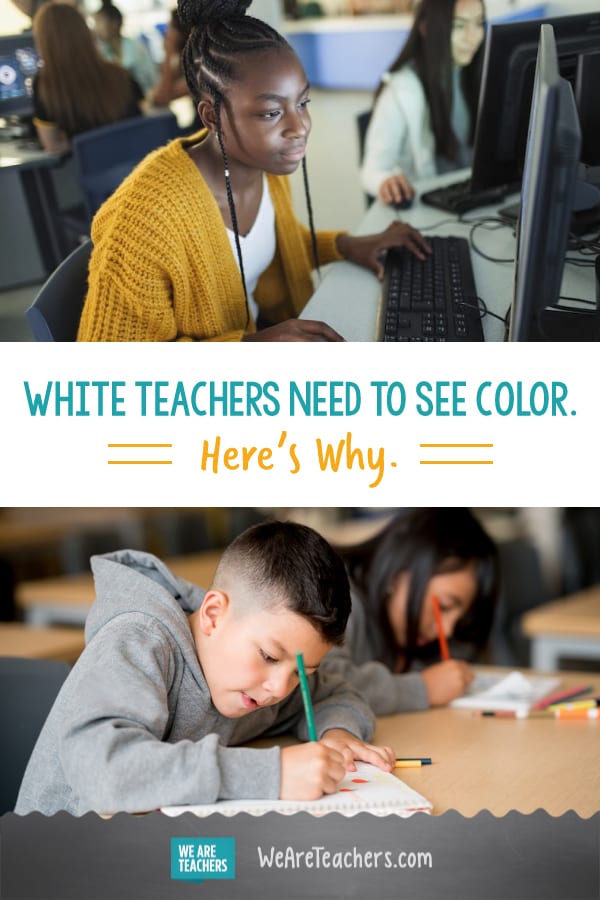When I first started writing, I wrote a piece called 10 Things I Wish my White Teacher Knew. I took some time to reflect on my school years as a black girl with mostly white teachers in Metro Detroit. I got a lot of positive feedback. One teacher said, “I loved your piece!” I thanked her and I told her she was a remarkable teacher, and our students were lucky to have her. She responded,“I don’t see color, I just see kids.” I knew she meant no harm, so I smiled. But it bothers me to this day I didn’t ask her to reevaluate her approach. So, I have been thinking about the eleventh thing I wish my white teacher knew: You need to see color.
You need to see color because there is nothing wrong with color.
The cure for racism in education is not colorblindness. Colorblindness erases the student’s individuality in the educational space. The statement is a microaggression, or a statement with an undercurrent of prejudice, which says that your racial and cultural identity is not a factor. Our students are grappling with their identity and race is a part of that. The way our world is set up, black and brown kids have to be taught self-love on purpose. So, provide opportunities which allow them to broadcast their racial and ethnic identities, and be proud of it! It’s okay to say things like “black is beautiful,” and for a white educator to facilitate a discussion on race. It just has to come from the right place.
[contextly_auto_sidebar]
You need to see color so that you can lift up students’ perspectives.
If you are a white teacher in a minority classroom, you may not understand your students’ perspective on certain issues. For example, the flag demonstration #takeaknee—Kaepernick says he is taking a knee to bring light to police brutality and injustice. However, there is another loud voice which says he is disrespecting troops. This “narrative switching” is very popular tool for white supremacists. Historically, when people of color stepped “out of order” people in power changed the narrative. So much that minorities were branded as troublemakers, even to their own people.
Teachers, it is important that you understand the dichotomy of your reality and theirs, and color is necessary for that. You don’t have to agree with your students’ perspectives. However, it is necessary that we understand black and brown children may experience and interpret events differently than yourself. When you try to change that narrative, you erase their unique experiences which shape them—you whitewash them. Do not find yourself on the wrong side of this issue. Allow open conversations so children can speak truth to power. Model how in America people can have different perspectives and coexist.
You need to see color because your black and brown students do not have the luxury to unsee color.
Minority students are taught to be constantly aware of themselves and others. I remember when I had my first job interview. My mom took me shopping. We had a hard time finding a nice suit that was professional, but that didn’t appear too aggressive. Then a harder time wearing ballet flats because I did not want to appear to be domineering. Every person of color has a similar story where an elder takes time to talk about the way their physical appearance is interpreted by white people. Do white people talk about how to make themselves appear more culturally aware in interviews?
Too often we minorities quiet ourselves to not appear too black or ethnic out of fear that we will be seen as undesirable. As a white teacher of minority students you should create a space where your students are not worried about you judging them for being themselves; i.e getting loud, laughing infectiously, even blowing hot air out of their mouths. Take their words at face value and adopt a policy of assuming positive intent, even if your logic or history has taught you otherwise.
Teachers need to see color because it is one of the things that make your students unique.
Every time a white teacher says, “I don’t see color,” you abandon a child in an educational void by refusing to recognize them for who they are. Additionally you fail to prepare them to enter a world who will see their color as a factor to their success and abilities. As more white teachers travel into predominantly black schools to teach, and students of color migrate into affluent white communities to learn, I get excited about the possibilities. On the other hand, I fear they will become less self-aware of their cultural significance and asked to blindly assimilate. So, if this is going to work, it is time to kill the idea of the colorblind white teacher for minority students.
Join us in our WeAreTeachers HELPLINE group on Facebook to talk about your teaching questions, including those around teaching and race.


